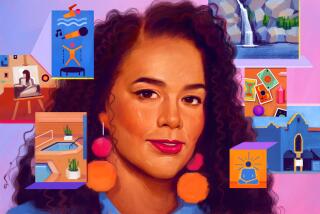They Are Foursquare Behind Life With Quadruplets
- Share via
You would think that Janet Lederhaus, 29, with her brood of 2 1/2-year-old quadruplets, plus a 7-month-old baby girl, would want to lap up nothing but leisure on Mother’s Day.
Instead, in the midst of the family celebration, she will no doubt go right on storing up more pointers to share with parents like herself in a project that she hopes will become a national Quad Club.
Already she is considered a minor guru among some of these parents, who found her through her articles in a magazine and newspaper before and after the birth of her quads Nov. 21, 1983.
The 5-foot-3, 98-pound mother of five and her husband, Scott, 33, admit, however, to “being pooped.”
They have just gone through the rigors of moving from Santa Ana to “a yuppie neighborhood” in northeast Claremont. And Scott is commuting to UC Irvine Medical Center to finish his residency in neurosurgery before joining a Pomona practice in July.
140 or More Quad Sets in U.S.
But somehow they have gotten their act together by creating a blend of outside help and following their determination to set aside time alone--for each other and themselves.
Janet Lederhaus, a pediatric nurse by profession, hopes that she can be of some help to the parents of the 140 or more sets of quadruplets in the United States through a formal organization. Already she thinks she is of help to some by answering their letters asking her advice.
“Beyond the practical things we’ve learned,” she said, “I’d like to share our philosophy about looking at the early years with the quads at home as a special time that will pass very quickly. In our case, we’re only one year away from having them in preschool. Besides their being away for part of each day, they will change rapidly from then on, and our life will too.”
All of this philosophizing was unfolding in the kitchen of the spacious Lederhaus home with a view, through sliding-glass doors, of the quads playing on the backyard lawn. Appearing relaxed, Janet was eager to describe the quads individually. She explained that she has learned to assume a hands-off policy while they play unless some real dispute develops.
There were Keith and Kate banging a plastic ball with toy golf clubs near the house and Eric and Jeff exploring snail activity at the back fence.
Eric, the first born, weighed 3 pounds at birth and is described as the most sensitive and responsible. Jeff, born second at 2 pounds, 11 ounces, is now the smallest but is the ringleader and the most aggressive. Kate, 2 pounds, 9 ounces at birth, as the only girl is very independent with a mind of her own, according to her mother, and Keith, 2 pounds 9 1/2 ounces at birth, is the quietest--a loner who likes to escape the confusion.
By now, they weigh around 26 pounds each and closely resemble each other, even though they are fraternal--not identical--quads.
“I think they are a little ahead of their age,” their mother said, “especially in communication, because there are four of them and they socialize. And through videotapes they know their ABCs, can count to 20, and can distinguish colors by name.”
The saga of the Lederhaus quads is almost miraculous considering the fact that the couple lost another set of quads at Christmastime, 1982, and the odds against having a second set are high.
“The first ones were only in their 24th week,” she said sadly, “three girls and a boy, and it will always bother us. I’m an optimist but I didn’t know how Scott would feel about my conceiving again so I suggested that we try to adopt. He said, ‘No, let’s try again.’ ”
Janet went back to work as a pediatric nurse at Children’s Hospital of Orange County, and in a few months, through the continued use of fertility drugs, she was pregnant again. While visiting her parents in Chicago in her seventh week of pregnancy, Janet learned there were actually five fetuses this time, but one had to be removed then because, as an ectopic pregnancy, it ruptured the tube.
“I went to bed (at home in Santa Ana) the 13th week,” she said, “and in the 24th week I checked into Children’s Hospital. It was crucial that I carry them beyond the 28th week, and since I had friends at the hospital, the same one where I worked as a nurse, I had a pretty good time. We used to mark off the calendar together, and once the 28th week had passed, we celebrated with margaritas.”
The quads were born at 29 1/2 weeks by Caesarean section, performed by Dr. Bernard Feldman with a support crew of 25 ringing the delivery table. They spent seven weeks in the hospital and came home within four days of each other. And then the fun began.
Developed a Schedule
The Lederhauses have developed a well-organized schedule. Janet rises at 5:30 to read the paper and eat breakfast. Jenna, the happy and not-at-all-neglected 7-month-old, is dressed and readied at 6:30, and at 7, the quads arise. They are fed and then play all morning, sometimes at home, often at a nearby recreational facility called The Club.
After lunch the quads sleep from 1 to 3, and the Lederhaus nanny, Maria Castillo, 21, gets the house and laundry in shape while Janet runs errands or swims at The Club. The quads have dinner at 5; after a bath, all in one tub, and prayers and songs, they are in bed by 6:15.
Then the parents, depending on Scott’s schedule, have dinner and the evening together.
Once a week the whole family piles into their eight-passenger van and goes to McDonald’s for a dinner out, but Scott and Janet make sure they have a real date alone once a week too. And they still entertain friends at home.
“And I make sure I pursue my own interests as far as I can,” Janet said. “I attend an aerobics class at The Club three or four early mornings a week, and Scott’s parents (Dick and Doris Lederhaus of Redondo Beach) come here once a week, so that I can get away a full day. Their help is invaluable.”
Some Financial Help
Concerning the expense of raising quads, Scott admitted, “It’s been tough. We’re budgeted pretty close. For example, diaper costs alone are $250 a month, but that isn’t forever. They should be toilet-trained at 3. Once I’m in practice, it will be easier. In the meantime, we have had to rely on my parents for some financial help.”
All of what they have learned “by doing” has been shared with parents of quads who have asked. “For example, how do I get five young children from one place to another? I put Jenna on my back and put a wristband device on the other four and away we go,” Janet explained.
Scott too contributed his inventiveness in the early months through a feeding device he called “auto-mom.”
“What it was,” he said, “was an inclined plane made of wood, with foam rubber cushions to hold the head of each child and Velco straps to hold the baby bottles. They could feed on their own all at the same time.”
“When the kids first came home,” Janet said, “they were fed every three hours, so this thing really helped.”
The couple have learned, too, that friends and relatives are anxious to help, and they call upon them when things “get too monotonous.”
Janet said that many of the letters that have come in since her article in Redbook, Christmas ‘85, and her series in the Orange County Register that ran from mid-1983 to mid-1984 are from parents-to-be who know quads are in their future and want to know what to expect in practical terms.
In her early articles, before the second set of quads was born, Janet shared with her readers the grief she and Scott felt over the first set as they died one by one, how she tried to ease the numbness by returning to work in pediatrics, but how she and Scott knew that only another child of their own would bring genuine comfort.
The Saga Resumed
Shortly after the homecoming of their second set of quads, Janet resumed her saga, telling about “auto-mom” and how it reduced feeding time and how they managed 360 diaper changes a week. Underlining all these practical details, however, were Janet’s expressions of anxiety over the threat of SIDS (Sudden Infant Death Syndrome) and other health perils to which premature babies are more susceptible--and how she and Scott dealt with their fears.
“We’ve been through it and we’ve learned a lot along the way. By the time the quads are almost 4, they will be in preschool at the Claremont Baptist Church, and Jenna will be on her way fairly soon after that. I really would like to have this club idea going. There are well-established organizations for parents of twins and triplets, with newsletters, meetings and other activities. And while the number of sets of quads is not large, their parents need lots of help and support along the way.
“They have to learn, as we did, that the only way to survive is with patience, working together and trying to keep a good sense of humor,” she concluded. “It’s an experience that few people can ever have.”


